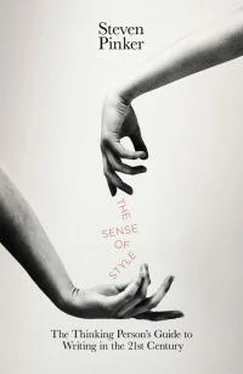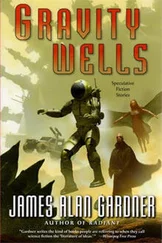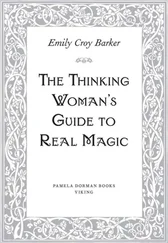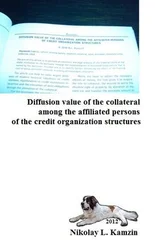And this brings us to Hume’s third category of connections, cause and effect. Here again the English language is mathematically elegant and provides the writer with a neat group of symmetries. She can state the cause first or the effect first, and the causal force can either make something happen or prevent it from happening.
Coherence Relation
Example
Typical Connectives
Result (cause-effect)
Young herons are inexperienced, so some of them migrate to Cape Cod.
and, as a result, therefore, so
Explanation (effect-cause)
Some herons migrate to Cape Cod, because they are young and inexperienced.
because, since, owing to
Coherence Relation
Example
Typical Connectives
Violated expectation (preventer-effect)
Herons have a tough time when the ponds freeze over. However, they will hunt and eat many other things.
but, while, however, nonetheless, yet
Failed prevention (effect-preventer)
Herons will hunt and eat many things in winter, even though the ponds are frozen over.
despite, even though
One other major coherence relation doesn’t easily fit into Hume’s trichotomy, attribution: so-and-so believes such-and-such. Attribution is typically indicated by connectives like according to and stated that. It’s important to get it right. In many written passages it’s unclear whether the author is arguing for a position or is explaining a position that someone else is arguing for. This is one of the many problems in Bob Dole’s sentence about intervening in Serbia (page 112).
There are a few other coherence relations, such as anticipations of a reaction by the reader ( yes; I know, I know ). There are also gray areas and various ways to lump and split the relations, which give linguists plenty of things to argue about. 13But these dozen or so cover most of the territory. A coherent text is one in which the reader always knows which coherence relation holds between one sentence and the next. In fact, coherence extends beyond individual sentences and also applies to entire branches in the discourse tree (in other words, to items in an essay outline). Several propositions may be interconnected by a set of coherence relations, and the resulting chunk is in turn connected to others. For example, the heron chowing down feral kittens was similar to the herons eating crustaceans, mice, and small birds. The entire set of these meals is now united as a single block of text which serves as an exemplification of herons eating things other than fish. And their ability to eat nonfishy meals is, in turn, an elaboration of their being opportunistic hunters.
Coherence relations among sets of sentences need not be perfectly treelike. They also drape across long stretches of text. The odd behavior of defending a frozen fishing hole connects all the way back to the reader’s question at the beginning of the column. It is an explanation, a cause of the effect she was asking about.
As a writer bangs out sentences, she needs to ensure that her readers can reconstruct the coherence relations she has in mind. The obvious way to do this is to use the appropriate connectives. The “typical” connectives in the charts, however, are only typical, and writers can leave them out when the connection is obvious to the reader. It’s an important choice. Too many connectives can make it seem as if an author is belaboring the obvious or patronizing the reader, and it can give prose a pedantic feel. Just imagine the sequence Herons live in the northern United States; similarly, herons live in most of Canada. Or Herons have one thing in their favor. … In contrast, herons have one thing not in their favor. Too few connectives, on the other hand, can leave the reader puzzled as to how one statement follows from the last.
Even more challenging, the optimal number of connectives depends on the expertise of the reader. 14Readers who are familiar with the subject matter will already know a lot about what is similar to what else, what causes what else, and what tends to accompany what else, and they don’t need to have these connections spelled out in so many words. They may even get confused if the writer spells out the obvious ones: they figure that she must have a good reason to do so and therefore that she must really be making some other claim, one that isn’t so obvious, which they then waste time trying to discern. In the case of where herons live, most readers know that the northern United States is contiguous to Canada and that the two have similar ecosystems, so they don’t need a similarly. If the author had mentioned less familiar birds and territories—say, that crested honey buzzards live in Yakutsk and Shenyang—the reader might appreciate being told whether the territories are similar, which would imply that the species is adapted to a specific ecosystem, or dissimilar, implying that it is widespread and flexible.
Figuring out the right level of explicitness for coherence relations is a major reason that a writer needs to think hard about the state of knowledge of her readers and show a few of them a draft to see whether she got it right. It’s an aspect of the art of writing which depends on intuition, experience, and guesswork, but there is also an overarching guideline. Humans are cursed with attributing too much of their own knowledge to others (chapter 3), which means that overall there is a greater danger of prose being confusing because it has too few connectives than pedantic because it has too many. When in doubt, connect.
If you do indicate a connection, though, do it just once. Prose becomes stuffy when an insecure writer hammers the reader over the head with redundant indicators of a connection, as if unsure that one would be enough.
Perhaps
the reason
so many people are in the dark is
because
they want it that way. [explanation]
Perhaps the reason so many people are in the dark is that they want it that way.
There are many biological influences of psychological traits
such as
cognitive ability, conscientiousness, impulsivity, risk aversion,
and the like
. [exemplification]
There are many biological influences of psychological traits such as cognitive ability, conscientiousness, impulsivity, and risk aversion.
We
separately
measured brainwide synchronization in local
versus
long-range channel pairs. [contrast]
We separately measured brainwide synchronization in local and long-range channel pairs.
The first redundancy, the reason is because, is widely disliked, because the word reason already implies that we are dealing with an explanation, and we don’t need a because to remind us. (Some purists also frown on the reason why, but it has been used by good writers for centuries and should be no more exceptionable than the place where or the time when .) Gratuitous redundancy makes prose difficult not just because readers have to duplicate the effort of figuring something out, but because they naturally assume that when a writer says two things she means two things, and fruitlessly search for the nonexistent second point.
Coherence connectives are the unsung heroes of lucid prose. They aren’t terribly frequent—most of them occur just a handful of times every 100,000 words—but they are the cement of reasoning and one of the most difficult yet most important tools of writing to master. A recent analysis of underperforming high school students showed that many of them, even those who read well, were stymied by the challenge of writing a coherent passage. 15One student, asked to write an essay on Alexander the Great, managed to come up with “I think Alexander the Great was one of the best military leaders,” then turned to her mother and said, “Well, I got a sentence down. What now?” A failure to command coherence connectives turned out to be among the skills that most sharply differentiated the struggling students from their successful peers. When these students were asked to read Of Mice and Men and complete a sentence beginning with “Although George,” many were stumped. A few wrote, “Although George and Lenny were friends.” The teachers introduced a program that explicitly trained the students to construct coherent arguments, with a focus on the connections between successive ideas. It was a radical shift from the kind of assignment that dominates high school writing instruction today, in which students are asked to write memoirs and personal reflections. The students showed dramatic improvements in their test scores in several subjects, and many more of them graduated from high school and applied to college.
Читать дальше












